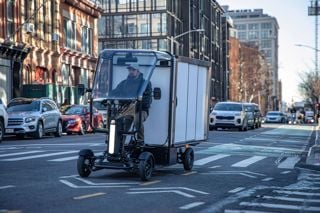Flying cars have long been heralded as the future of transport, with columns of airborne vehicles often portrayed making their way through towering skyscrapers.
From colourful 1960s cartoon The Jetsons to 1990s Hollywood blockbusters such as The Fifth Element, the message from science-fiction writers was clear: flying cars were the future.
However, while this genre has successfully predicted the future in many areas, the way corporate mobility will develop seems, in the main, more grounded.
Industry experts now predict that autonomous vehicles, connected cars and a growing focus on providing door-to-door mobility for consumers will play a prominent role in the immediate future.
Products such as car-sharing and mobility cards are also expected to grow, as companies move towards ‘asset light, technology heavy’ transport solutions.
Research and consultancy company Frost & Sullivan also expects fleet operators across Europe to increasingly become mobility managers as their role diversifies.
Here we focus on the session covering the future of corporate mobility which was held at the recent Frost & Sullivan Intelligent Mobility conference.
LeasePlan UK
Hein du Plessis, head of product development LeasePlan UK says leasing companies have an important role to play in helping businesses adopt a mobility model.
During the conference, Du Plessis was told that some companies that lease cars could help pay for the vehicles by renting them out to other business while they were not being used.
In situations like this, a leasing company has to “become an enabler”, says Du Plessis.
“Looking at the UK market specifically, 55% of all vehicles are now leased, so the natural progression would be for the leasing companies to take a forward move,” he adds.
“From LeasePlan’s perspective, we really are moving away from the vehicle and more towards the journey.”
Frost & Sullivan
Graeme Banister, director of consulting in mobility practice, automotive and transportation at Frost & Sullivan, has seen a shift in the way companies across Europe approach business travel.
“Corporate mobility is a lot of things: it’s fleet, it’s business travel and it’s expenses,” he says.
“All of that put together makes it a dynamic landscape. We see companies across Europe moving from a total cost of ownership model for assets like company cars to total cost of mobility models.
“This will see companies move from managing a section of employees who have company cars to a mobility model which is integrated and which can be provided for all employees.”
However, Banister is keen to stress that this will not signal the end of the company car.
“The company car is, and will, remain the key part of how an organisation is mobile and how it does its business,” he says.
“What you will see is an increased interest in some of the sharing solutions, such as corporate car sharing and car pooling.”
Banister says corporate car sharing, in particular, has potential for “great growth” as fleets can use this to improve vehicle utilisation and make better use of pool vehicles.
Frost & Sullivan research shows five countries in Europe – the UK, Germany, France, the Netherlands and Belgium – are most aligned to considering mobility.
“From that we’ve looked and understood what products companies are using now and what products will interest them in the future,” says Banister.
One product which has been adopted in some countries is a mobility allowance, where employees are given a monthly budget and are able to choose the transport they use, such as car, taxi or train.
“If all of the component parts come together, you can actually say to an employee ‘here’s an opportunity to decide which products you want to use in the best way under the umbrella of a mobility allowance’.
“We saw interest in taking this forward across all countries, particularly Belgium and the Netherlands because of their geography and the way they are densely populated, so it’s easy to get from A to B.
“We found there is a great appetite to move from company car to mobility allowance.”
ACFO / Arcadia Group
John Pryor, chairman of ACFO and fleet and travel manager at Arcadia Group, says the Energy Savings Opportunity Scheme could provide businesses with the motivation to introduce mobility solutions.
The mandatory scheme means that, from December, medium and large companies must measure their total energy consumption across transport, buildings and industrial activities over a 12-month period.
“Now, you have got to start knowing what your energy consumption is, and therefore what your mileages are, what you are doing on rail and what you are doing on air,” says Pryor. “I think people will start seeing that data and will start asking what they want to do with regards to mobility.”
However, he says one potential problem businesses face with adopting a mobility model is knowing where this responsibility will sit within a company.
“Does it sit in a purchasing environment? Does it sit in a financial environment? Does it sit in an HR environment?” he says.
“We’ve got feeds from our travel agent, our expenses department and our company cars. So, we have got all this information there, but it is not always easy to get. One issue for corporations is knowing where that data is.
“Once you start getting there, it rolls on and on and, when you think you’ve caught it, there’s actually more that you’ve got to go into.
“That is why a lot of people don’t want to do it.”
Alphabet International
Carsten Kwirandt, head of marketing and business development, Alphabet International, feels corporate mobility will focus more on usage than owning vehicles in the future.
“We know that travelling is becoming more complex and the mobility user is asking for more inter-modal travelling solutions and for more flexibility,” he says.
“This morning in London I saw two stations where I could rent a bike. And there’s also the Oyster card.
“These initiatives allow people to choose their means of transportation. It will not always be their own vehicle: there is a trend of moving from asset to usage. The average usage of a car today is about 4%. If this was transferred to an airline, that airline would close down the next day because an asset being used just 4% of the time doesn’t pay off.
“Think about the asset of the car, how does that actually pay off?”
Kwirandt expects there will be a dramatic growth in car sharing. “The projection is that in four years’ time there will be 26 million car sharers across the world,” he says. “Today we are at two million.”
He adds: “I am in a business where we are funding a lot of cars. In many cases, we expect the lease cars will be replaced by other means of transportation, but not in the first instance.
“Instead they will be offered alongside them, because this is what the mobility user is asking for.”
Q & A
When do you think the tipping point will be when corporate mobility will be mass-adopted by large organisations?
Hein du Plessis, head of product development, LeasePlan UK: Traditionally the corporate market has led the retail. The widespread adoption of diesel cars is evidence of this. However, in the mobility space we definitely feel the retail market is pushing the corporate so, to a certain extent, the tipping point is happening as we speak.
There is a massive increase in car sharing in the retail sector and we feel that will flow upwards to the corporate market.
Nigel Aston, senior advisor corporate strategy, Amadeus: We hear a lot about the millennial generation. If it starts making demands of employers and that’s the only way that companies can secure the best employees, this upward pressure will create the tipping point for when large organisations really adopt corporate mobility. It’s impossible to put a firm date on it, but I think we will see a considerable difference in five years’ time.
Carsten Kwirandt, head of marketing and business development, Alphabet International: Generally, I would agree but if you look at it market-by-market, there are different degrees of maturity. The Netherlands is very mature in terms of operational leasing and is open to offering mobility budgets, ahead of other countries such as Poland, which are just discovering operational leasing. The tipping point is always ongoing.






















Login to comment
Comments
No comments have been made yet.